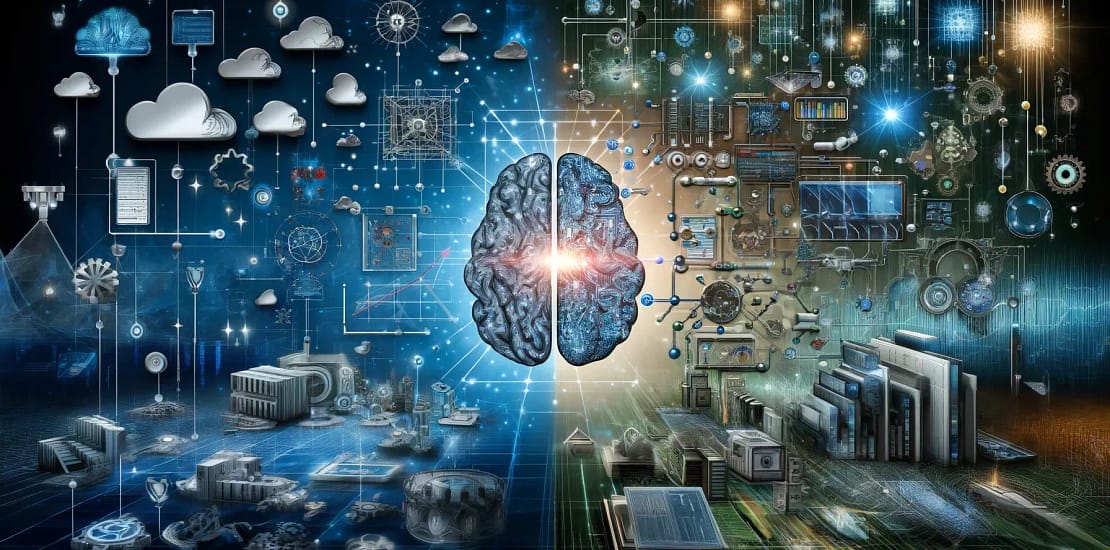Machine Learning vs. Deep Learning: Unraveling the Differences and Applications
- April 25, 2024
- Posted by: Cheryl Li
- Category: AI Technology Deep Dives

In recent years, the terms “machine learning” and “deep learning” have become increasingly popular, often used interchangeably in discussions about artificial intelligence (AI). While they are closely related, they are not the same. Understanding the distinctions between machine learning and deep learning is crucial for grasping their respective applications and potential. This blog post aims to clarify the differences between these two key AI technologies, exploring their definitions, methodologies, use cases, and how they complement each other.
Understanding Machine Learning
Machine learning is a subset of AI that focuses on the development of algorithms that enable computers to learn from and make decisions based on data. The core idea is that systems can automatically improve their performance through experience without being explicitly programmed for every task.
How Machine Learning Works

Machine learning algorithms are designed to identify patterns within data. These algorithms can be broadly categorized into three types:
- Supervised Learning: In this approach, the algorithm is trained on a labeled dataset, which means that each training example is paired with an output label. The goal is to learn a mapping from inputs to outputs. Common applications include image classification, spam detection, and predictive modeling.
- Unsupervised Learning: Here, the algorithm is given data without explicit instructions on what to do with it. The objective is to find hidden patterns or intrinsic structures in the input data. Examples include clustering, dimensionality reduction, and anomaly detection.
- Reinforcement Learning: This type of learning involves an agent that interacts with its environment by performing actions and receiving feedback in the form of rewards or punishments. The agent learns to maximize its cumulative reward. Applications include game playing, robotics, and resource management.
Key Machine Learning Algorithms
- Linear Regression: Used for predicting a continuous variable.
- Logistic Regression: Used for binary classification problems.
- Decision Trees: Models that split data into subsets based on feature values.
- Support Vector Machines (SVMs): Used for classification and regression tasks.
- K-Means Clustering: An unsupervised algorithm for grouping data points into clusters.
Understanding Deep Learning
Deep learning is a specialized subset of machine learning that involves neural networks with many layers (hence the term “deep”). These neural networks, known as deep neural networks, are capable of learning complex patterns in large amounts of data.
How Deep Learning Works
Deep learning models are built using artificial neural networks that mimic the human brain’s structure and function. These networks consist of layers of interconnected nodes, or neurons, where each connection has an associated weight. Deep learning networks typically include:
- Input Layer: Receives the input data.
- Hidden Layers: Layers between the input and output layers, where the learning takes place. There can be many hidden layers in a deep network.
- Output Layer: Produces the final output of the model.
The process of training a deep learning model involves adjusting the weights of the connections to minimize the difference between the predicted and actual outcomes. This is typically done using a technique called backpropagation, along with an optimization algorithm such as gradient descent.
Key Deep Learning Architectures
- Convolutional Neural Networks (CNNs): Primarily used for image and video recognition, as well as other spatial data processing.
- Recurrent Neural Networks (RNNs): Designed for sequential data and time series analysis, such as language modeling and speech recognition.
- Long Short-Term Memory Networks (LSTMs): A type of RNN capable of learning long-term dependencies, useful for tasks like text generation and machine translation.
- Generative Adversarial Networks (GANs): Used for generating realistic data, such as images, by having two networks (a generator and a discriminator) compete against each other.
Key Differences Between Machine Learning and Deep Learning
Data Requirements
One of the most significant differences between machine learning and deep learning is the amount of data required. Traditional machine learning algorithms can work with smaller datasets, while deep learning models typically require large volumes of data to perform well. This is because deep learning models have a large number of parameters that need to be learned, which necessitates more data.
Feature Engineering
In traditional machine learning, feature engineering is a crucial step where domain experts manually select and extract the features from the raw data that are most relevant for the learning task. In contrast, deep learning models can automatically learn the features from the raw data. This capability to perform automatic feature extraction makes deep learning particularly powerful for tasks involving unstructured data, such as images, audio, and text.
Computational Resources
Deep learning models are computationally intensive, requiring powerful hardware, such as GPUs (Graphics Processing Units) or TPUs (Tensor Processing Units), to train in a reasonable timeframe. Traditional machine learning algorithms, on the other hand, can often be run on standard CPUs without the need for specialized hardware.
Interpretability
Machine learning models, especially simpler ones like decision trees and linear regression, are generally easier to interpret and understand. The decision-making process of these models can often be traced back and explained. Deep learning models, however, are often considered “black boxes” due to their complex architectures and the difficulty in understanding how they arrive at specific decisions. This lack of interpretability can be a drawback in applications where transparency is critical.
Applications
While there is overlap in the applications of machine learning and deep learning, each has its strengths. Traditional machine learning is often used in scenarios where the dataset is smaller and the problem is well-defined, such as fraud detection, customer segmentation, and predictive maintenance. Deep learning excels in tasks involving large datasets and complex patterns, such as image and speech recognition, natural language processing, and autonomous driving.
Complementary Nature
Despite their differences, machine learning and deep learning are not mutually exclusive. In many applications, they complement each other. For instance, machine learning techniques can be used to preprocess data and extract relevant features, which are then fed into a deep learning model for further analysis. Similarly, insights gained from deep learning models can be used to refine and improve traditional machine learning algorithms.
Conclusion
Machine learning and deep learning are both essential components of the AI landscape, each with its unique strengths and applications. Understanding the differences between them is crucial for choosing the right approach for a given problem. Traditional machine learning is well-suited for problems with smaller datasets and where interpretability is important. Deep learning, with its ability to automatically extract features from large amounts of unstructured data, is ideal for complex tasks requiring high accuracy.
As AI continues to evolve, the integration and interplay between machine learning and deep learning will likely become even more pronounced, leading to more sophisticated and effective solutions across various domains. By leveraging the strengths of both approaches, we can push the boundaries of what AI can achieve, driving innovation and transforming industries.

